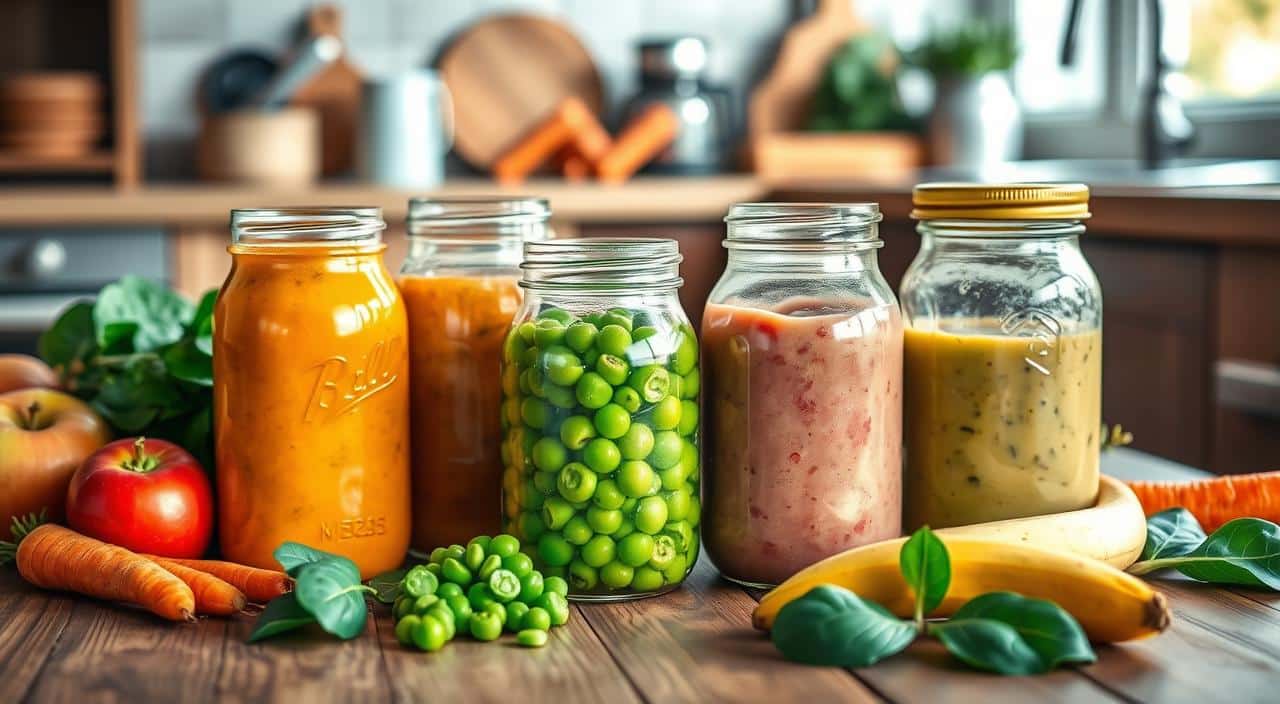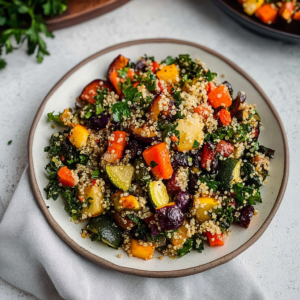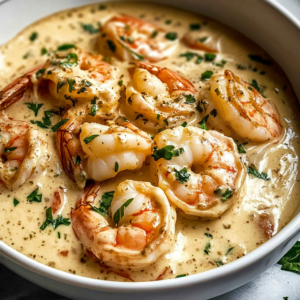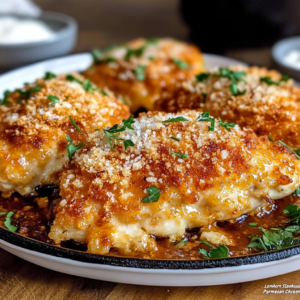Jump to:
Estimated reading time: 12 minutes
Table of contents
As a new parent, you want the best for your baby. Making healthy, nutrient-rich baby food recipes is a great way to start. This guide will show you how to make tasty meals that are good for your baby.
Looking into homemade baby purees or baby-led weaning? This article has lots of tips and ideas. You’ll learn about using fresh, organic ingredients and making recipes that fit your baby’s needs.
Key Takeaways
- Homemade baby food recipes offer superior nutrition and cost-effectiveness compared to store-bought options.
- Incorporating a variety of fruits, vegetables, grains, and proteins ensures a balanced and nutrient-dense diet for your baby.
- Customizing recipes based on your baby’s age, stage of development, and any dietary restrictions or allergies is essential for their well-being.
- Proper storage and freezing techniques can help preserve the nutritional value and freshness of your homemade baby food.
- Introducing a wide range of flavors and textures can help your baby develop a diverse palate and positive eating habits.
Introduction
Feeding our babies with healthy foods is a big deal for parents. This article will guide you to make your own baby food. You’ll learn about simple purees, finger foods, and more to help your baby grow.
Babies start eating solids around 6 months, says the American Academy of Pediatrics. It’s key to introduce many flavors and textures. Homemade food gives your baby the best nutrients and lets you choose what they eat.
We’ll look at the benefits of healthy baby food, the best ingredients, and easy recipes. You’ll also learn how to adjust recipes for your baby’s age and avoid common mistakes. Let’s start making healthy meals for your baby!
Cottage cheese recipesare great for babies. They offer protein and other important nutrients.
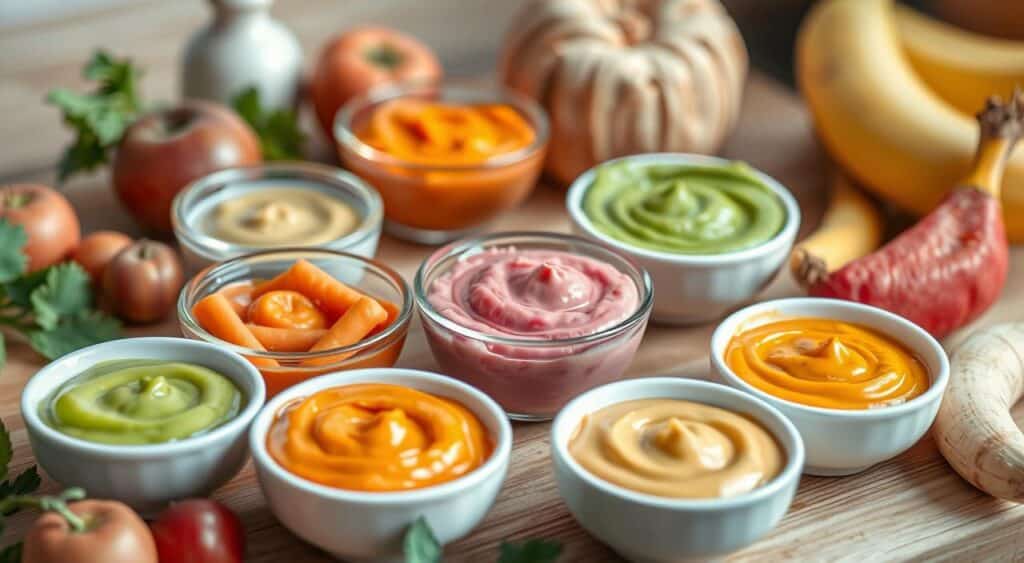
“Feeding our babies with healthy, nutrient-dense foods is a top priority for many parents.”
Why Choose Healthy Baby Food Recipes?
Feeding your baby is a big responsibility. Choosing healthy, homemade baby food recipes is a great choice. It ensures your baby gets the best nutrition from fresh ingredients.
Benefits of Homemade Baby Food
Homemade recipes save money and let you tailor meals to your baby’s taste. This is important because babies like different foods as they grow.
Fresh Ingredients for Maximum Nutrition
At home, you control the ingredients. Fresh foods give your baby all the nutrients they need for growth.
Cost-Effective and Customizable Recipes
Homemade food is cheaper and lets you adjust recipes for your baby. This way, your baby gets to enjoy their meals and gets the nutrients they need.
| Advantages of Homemade Baby Food | Benefits of Store-Bought Baby Food |
|---|---|
|
|
This section has shown why healthy, homemade baby food is a good choice. It’s about getting the best nutrition, saving money, and making meals your baby will love.
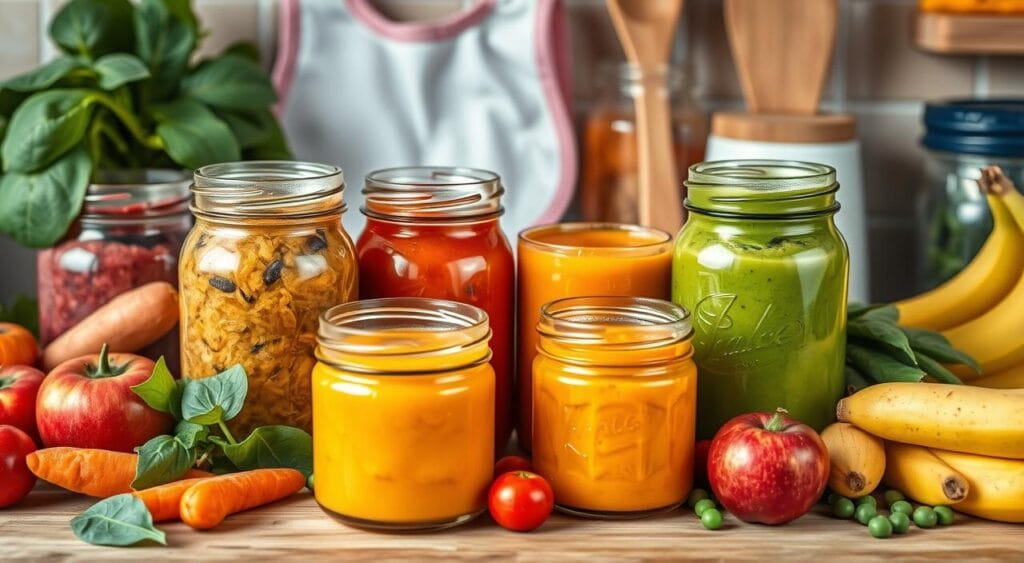
Best Ingredients for Healthy Baby Food Recipes
Choosing the right ingredients is key for nutritious baby food. This section will show you the best fruits, vegetables, grains, and proteins for homemade recipes. Learn how these ingredients provide essential vitamins and minerals for your baby’s growth.
Fruits: First Foods Full of Vitamins
Start with fresh, ripe fruits for your baby. Avocado, banana, pear, mango, and berries are great choices. They’re full of vitamins A, C, and E, and also offer fiber and healthy fats.
Vegetables: Packed with Nutrients
Vegetables are a great source of nutrition for your baby. Try sweet potatoes, carrots, spinach, broccoli, and green beans. They’re packed with vitamins, minerals, and antioxidants for your baby’s development.
Grains and Proteins for Balanced Meals
Add whole grains and proteins to your baby’s meals. Quinoa, oats, and brown rice are good for complex carbs and fiber. Chicken, turkey, and lentils help with muscle growth and development.
By choosing a variety of these ingredients, you can make healthy baby food. This ensures your little one gets a balanced diet for their growth.
| Ingredient | Nutritional Benefits |
|---|---|
| Avocado | Rich in healthy fats, vitamins C, E, and K, and folate |
| Sweet Potato | High in vitamin A, vitamin C, and fiber |
| Quinoa | A complete protein source with essential amino acids |
| Spinach | Packed with iron, vitamin K, and antioxidants |
| Lentils | An excellent source of plant-based protein and fiber |
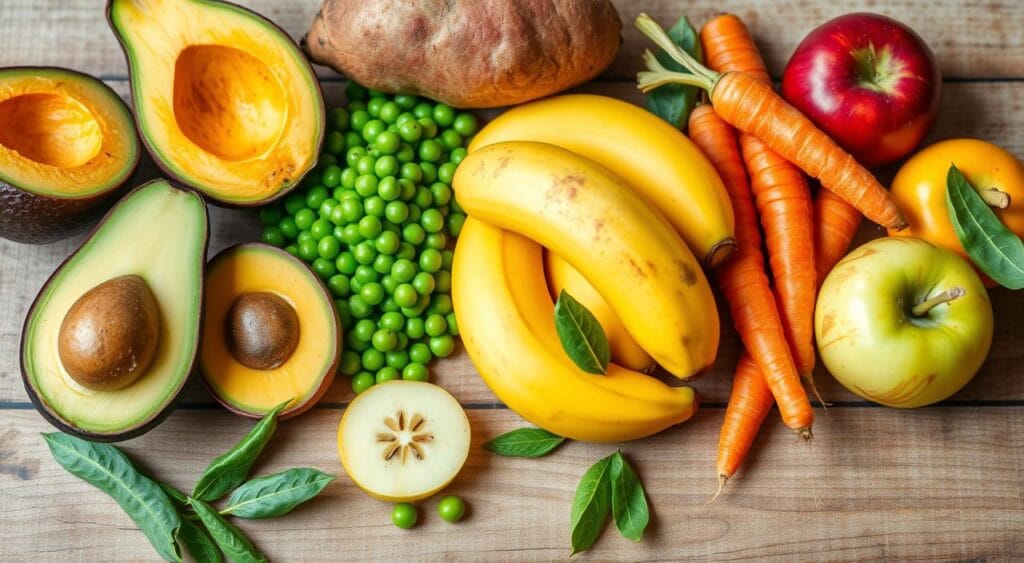
By using a variety of these nutrient-rich foods, you can make homemade baby food. This supports your baby’s growth and development.
Simple and Nutritious Healthy Baby Food Recipes
Discover three delicious and easy-to-make healthy baby food recipes. The mashed avocado and banana offers healthy fats and natural sweetness. The sweet potato and carrot puree is full of vitamins and minerals. The quinoa and spinach mash provides a balanced meal with protein, grains, and greens.
Recipe 1: Mashed Avocado and Banana
This creamy recipe is perfect for first-stage baby foods. Mash ripe avocado and banana together until smooth. Serve it for a healthy start to solid foods.
Recipe 2: Sweet Potato Puree with Carrots
Roast sweet potatoes and carrots until tender. Then blend them into a smooth puree. This vibrant orange mixture is full of vitamins A and C, and other essential nutrients for your baby.
Recipe 3: Quinoa and Spinach Mash
Cook quinoa according to package instructions. Then mix it with cooked, finely chopped spinach. This balanced meal offers protein, complex carbohydrates, and leafy greens for your little one.
Remember to introduce new foods one at a time and watch for any allergic reactions. These simple and nutritious recipes are a great way to start your baby on a journey of healthy eating.
How to Customize Healthy Baby Food Recipes for Your Baby
As your baby grows, it’s key to introduce new tastes, textures, and ingredients. This section offers tips on customizing healthy baby food recipes. Learn how to tweak ingredients and cooking methods to meet your baby’s changing needs.
Introducing New Flavors and Textures
By six months, many babies are ready to try new flavors and textures. Start with single-ingredient purees and then mix things up. Watch how your baby reacts to new foods to know when to move on.
How to Adjust Recipes for Age and Stage
Stage 1 baby foods are watery and single-ingredient, for six-month-olds. At stage 2 foods are thicker and for 6 to 9 months. Stage 3 foods are chunkier and for 10 to 12 months. Adjust the recipe’s consistency and ingredients to fit your baby’s growth.
Adding Herbs and Spices for Flavor Variety
When your baby’s taste buds mature, you can add mild herbs and spices. Start with small amounts and watch for reactions. Try cinnamon, nutmeg, dill, and basil. Mix flavors to keep meals exciting and encourage trying new things.
Common Mistakes to Avoid When Making Baby Food
Making homemade baby food can be rewarding. But, there are mistakes to avoid for your baby’s safety and happiness. This section will cover some common issues when preparing healthy baby food.
Using Ingredients That Are Too Hard to Digest
Babies start with small amounts of solid food around six months. By 12 months, they eat three small meals a day. It’s key to pick ingredients that are gentle on their digestive system.
Fresh fruits and veggies can have harmful bacteria. These are especially risky for kids under 5. Make sure to clean and prepare ingredients well to avoid foodborne illness.
Over-seasoning the Food
Avoid over-seasoning homemade baby food. Too much salt, spices, or additives can upset their taste and digestion. Use simple, natural flavors for their comfort and safety.
Not Considering Allergen Sensitivities
Be careful when introducing new foods to your baby. Food processed with honey should be avoided for babies under one year old due to the risk of botulism. Watch how your baby reacts to new foods. Most allergic reactions happen within minutes to two hours after eating.
By avoiding these mistakes, you can make sure your baby’s food is nutritious, safe, and tasty. With care and attention, babies can start a healthy and delicious eating journey.
Storing and Freezing Healthy Baby Food Recipes
Batch cooking and storing homemade baby food can be a game-changer for busy parents. Find out the best containers to use, how long you can store it, and freezing tips. This section will help you plan ahead and have healthy meals ready for your little one.
Best Storage Containers for Baby Food
Choosing the right containers for homemade baby food is key. Go for glass or BPA-free plastic ones that are easy to label and stack. Reusable baby food pouches are great for feeding on the go.
How Long Can You Store Homemade Baby Food?
- Refrigerator: Baby food stays fresh in the fridge for up to 3 days.
- Freezer: You can freeze it for up to 6 months, keeping it fresh longer.
It’s best to store a month’s worth of a recipe at a time. This helps avoid waste and keeps food fresh.
Freezing Tips to Maintain Nutritional Value
- Freeze food in small portions for easy thawing and serving.
- Label containers with the recipe name and date.
- Thaw frozen baby food in the fridge overnight before serving.
- Avoid refreezing thawed baby food to keep its nutritional value.
By following these tips, you can enjoy batch cooking. Your baby will get the most nutritional benefits from homemade meals.
Nutritional Benefits of Healthy Baby Food Recipes
Homemade baby food recipes are packed with nutrients to help your child grow fast. This section will cover the key vitamins, minerals, and nutrients babies need. You’ll learn how to mix fruits, veggies, grains, and proteins into their meals.
Essential Nutrients for Babies’ Growth
Babies need a special diet to grow quickly. Homemade recipes can give them lots of important nutrients. These include:
- Vitamin A for eye health and immune function
- Vitamin C to support the immune system and collagen production
- Iron for red blood cell formation and brain development
- Calcium and Vitamin D for strong bones and teeth
- Protein for muscle growth and tissue repair
Importance of Balanced Meals with Fruits, Veggies, and Grains
It’s key to give your baby a mix of fruits, veggies, grains, and proteins. This ensures they get all the vitamins and nutrients they need. The recipes in this article help you make meals that are full of flavor and good for your baby’s health.
How to Ensure Your Baby Gets Enough Protein
Protein is vital for your baby’s growth and health. To make sure they get enough, add:
- Pureed meats, poultry, or fish
- Mashed beans, lentils, or tofu
- Smooth nut or seed butters
- Whole milk or full-fat dairy products
With the recipes from this article, you can give your baby the nutrition they need to grow strong and healthy.
FAQ: Healthy Baby Food Recipes
What homemade food can babies eat?
Babies can eat a variety of homemade foods, including single-ingredient purees like carrots, sweet potatoes, apples, and avocado. As they grow, you can introduce thicker purees, soft fruits, and mixed vegetables, focusing on simple, whole ingredients. Discover more homemade baby food ideas here.
What are good baby foods to start with?
Good starter foods for babies include single-ingredient purees like mashed banana, sweet potato puree, avocado mash, pear puree, and oatmeal. These foods are gentle on digestion and provide essential vitamins and minerals. Start with one food at a time to monitor for any potential allergies. Learn more about baby’s first foods here.
What are the 5 types of baby food?
The 5 main types of baby food include:
Single-ingredient purees (e.g., apple or carrot puree).
Multi-ingredient purees (e.g., peas and carrots).
Finger foods (e.g., soft-cooked veggies, small banana pieces).
Cereals and grains (e.g., rice cereal, oatmeal).
Protein-rich foods (e.g., pureed chicken, lentils, or yogurt).
These categories provide a balanced approach to introduce flavors and textures gradually. Learn more about types of baby food here.
What baby foods are good mixed together?
Some tasty and nutritious baby food combinations include:
Apple and spinach – Adds natural sweetness with added iron.
Sweet potato and chicken – A protein and fiber-rich combination.
Banana and blueberry – Provides antioxidants and potassium.
Carrot and peas – Adds color, fiber, and a slightly sweet flavor.
Oatmeal with mashed banana – Perfect for breakfast and easy on digestion.
Mixing foods allows for more complex flavors and nutrients as babies’ palates and digestive systems mature. Find more baby food combinations here.
| Homemade Baby Food Recipes | Best for Ages |
|---|---|
| Avocado Puree, Bean Puree, Blueberry Puree | 5-6 months |
| Kiwi Puree, Mango Puree, Peach Puree | 6-7 months |
| Whipped Peanut Butter, Pineapple Puree, Strawberry Puree, Banana Puree | 7-8 months |
Conclusion: Starting Your Baby on a Journey of Healthy Eating
Starting your baby on solid foods is a big step. It’s important to teach them healthy eating habits early on. Homemade baby food recipes are full of nutrients and can make mealtime fun and nutritious for years to come.
Making your own baby food means your child gets the best ingredients. It also helps them develop a good relationship with food. Studies show that babies who are breastfed tend to be less picky eaters. They are also more likely to try new foods quickly.
Feeding your baby a variety of foods is key. This includes fruits, veggies, grains, and proteins. By starting with solid foods wisely, you’re helping them grow up to be healthy eaters. Enjoy the journey of feeding your child with homemade, nutritious meals.
More Easy Lunch Recipes:
- Irresistible One Pot Keto Garlic Butter Parm Meatballs!
- Irresistible Egg-Free Keto Peanut Butter Cookie Bliss!!
- Cheesy Beef Rigatoni Pasta – Easy 45-Minute Recipe
- Zesty Chili Lime Shrimp Tacos: Coastal Quick Gourmet Meal
Recommended
📖 Recipe Card
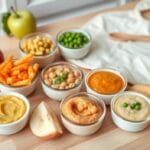
Healthy Baby Food Recipes: Apple and Oatmeal Puree
- Total Time: 15 minutes
- Yield: 4 servings (about 1/4 cup each) 1x
Description
This Apple and Oatmeal Puree is a fiber-rich, gentle introduction to grains for babies. The natural sweetness of apple makes it a tasty choice that’s easy on your baby’s tummy.
Ingredients
- 1 small apple, peeled, cored, and diced
- 2 tbsp oats (quick oats or rolled oats)
- 1/2 cup water or breast milk/formula (for desired consistency)
Instructions
- In a small saucepan, combine the oats and water. Add the diced apple and bring to a gentle boil.
- Reduce the heat and simmer for 10 minutes, or until the apple is soft and the oats are cooked through.
- Let cool slightly, then transfer to a blender and blend until smooth. Add more water or breast milk/formula to achieve the desired consistency if needed.
- Allow to cool before serving to your baby.
Notes
- Storage: Store any leftovers in an airtight container in the refrigerator for up to 3 days or freeze in ice cube trays for individual servings.
- Texture: Blend to a smooth consistency for younger babies or leave it a bit chunky for babies transitioning to more textured foods.
- Prep Time: 5 minutes
- Cook Time: 10 minutes
Nutrition
- Serving Size: 1/4 cup
- Calories: 40
- Sugar: 3g
- Sodium: 1mg
- Fat: 0g
- Saturated Fat: 0g
- Unsaturated Fat: 0g
- Trans Fat: 0g
- Carbohydrates: 8g
- Fiber: 1g
- Protein: 1g
- Cholesterol: 0mg
